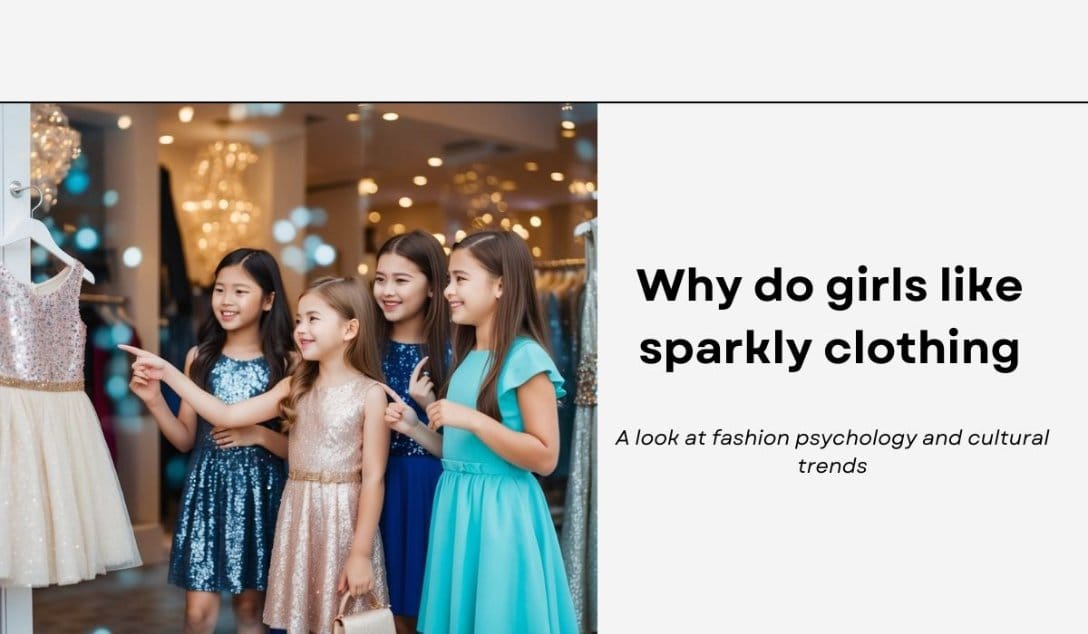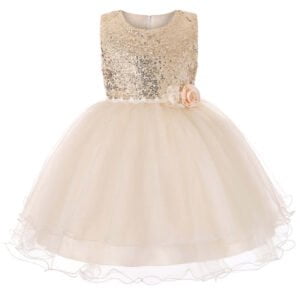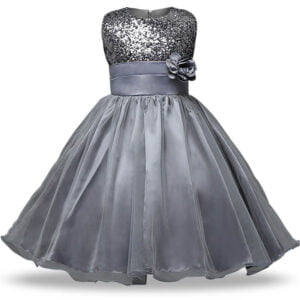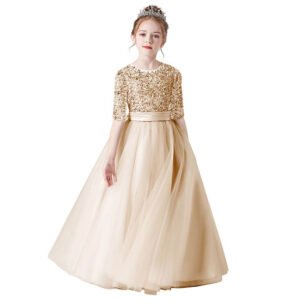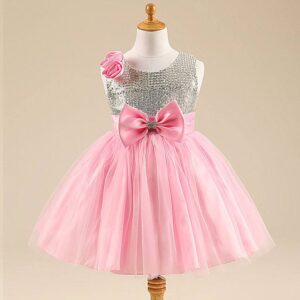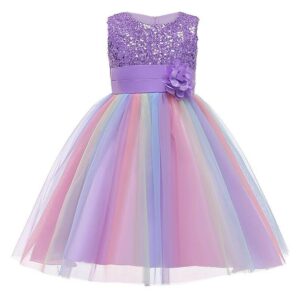From Glitter to Sequins: Understanding the Science Behind the Sparkle Attraction
Girls often gravitate towards sparkly clothing for various reasons. The attraction to shimmering fabrics and glittery designs goes beyond mere aesthetics. Studies suggest that humans are naturally drawn to shiny objects, which may explain the appeal of sparkly clothing across different age groups.
Sparkles and glitter have become increasingly popular in fashion, appearing in everything from casual wear to formal attire. This trend reflects a broader cultural fascination with eye-catching, luminous materials. Many girls find that sparkly clothing helps them stand out and express their personality in a unique way.
The choice to wear sparkly clothing can also be influenced by social factors and personal confidence. Some girls feel more empowered and self-assured when donning shimmering outfits, viewing them as a form of self-expression and a way to celebrate their individuality.
On This Page
Key Takeaways
- Humans have a natural attraction to shiny objects, including sparkly clothing
- Sparkly attire allows for unique self-expression and personality showcasing
- Wearing glittery outfits can boost confidence and feelings of empowerment
Historical Context of Sparkly Clothing
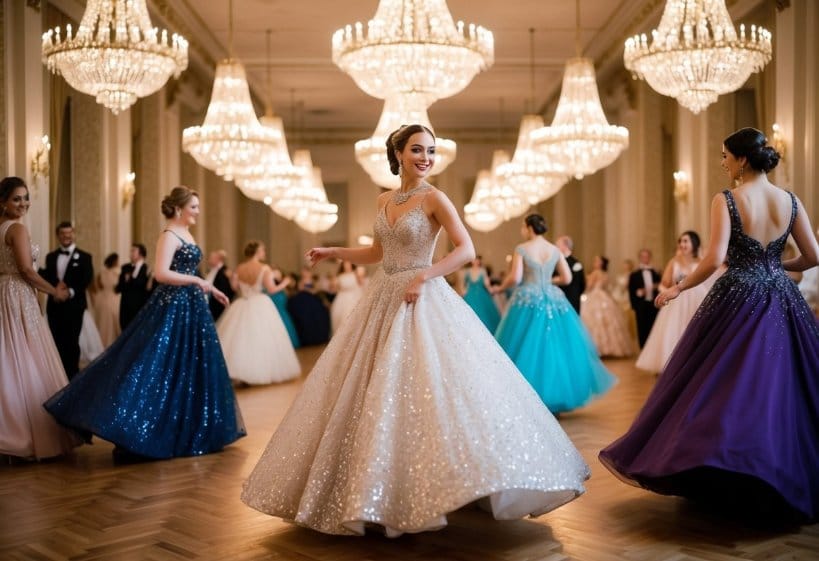
Sparkly clothing has a rich history spanning centuries. Its popularity has ebbed and flowed with changing cultural norms and fashion trends. Two key factors shaped its evolution: societal influences and the fashion industry’s innovations.
Influence of Cultural Norms
In the early 20th century, sparkly clothing was often associated with wealth and glamour. The Jazz Age saw sequins and glitter become popular in flapper dresses and stage costumes. This trend reflected the era’s desire for extravagance and rebellion against conservative dress codes.
In the 1970s and 1980s, sparkly clothing became linked with disco culture and glam rock. Artists like David Bowie and Madonna popularised glittery outfits, making them symbols of self-expression and individuality.
The 1990s saw a shift towards more casual fashion. However, sparkly accessories remained popular, especially among young girls. Glittery hair clips, shoes, and bags were common fashion items.
Evolution in Fashion Industries
The fashion industry has played a crucial role in making sparkly clothing more accessible. In the early days, sequins and glitter were expensive, limiting their use to high-end fashion and costumes.
Technological advancements in the mid-20th century led to the production of cheaper, synthetic glitter. This made sparkly fabrics more affordable and widely available.
Today, major fashion chains regularly stock sparkly items. The rise of fast fashion has made it easier for consumers to incorporate glitter into their everyday wardrobes.
The industry has also responded to environmental concerns. Many brands now offer eco-friendly glitter options, addressing the issue of microplastic pollution caused by traditional glitter.
The Psychology Behind Attraction to Sparkles
People are naturally drawn to sparkly and shiny things. This attraction affects how we perceive beauty and influences fashion choices. Our brains respond to glittery objects in unique ways that relate to our evolution and cognitive processes.
Cognitive Response to Shiny Things
The human brain reacts strongly to sparkly objects. Shiny things grab our attention and stimulate visual processing areas. This quick focus on gleaming items likely helped our ancestors spot water sources.
Sparkles can trigger positive emotions. Many people associate glittery clothes with fun events and happy memories. This mental link makes sparkly outfits feel special.
Shiny objects also seem valuable to us. In nature, glossy surfaces often signal quality. This instinct extends to how we view sparkly fashion. Girls may feel more confident in sparkly clothes because they seem precious.
Sparkles and Human Evolution
Our attraction to sparkles has roots in human evolution. Early humans needed to find water to survive. Shiny surfaces that resembled water likely caught their eye.
This innate draw to gleaming objects stayed with us. Now it affects how we see beauty and choose clothes. Glittery fashion may appeal to a deep part of our brains that still seeks out shiny things.
Sparkles can also express individuality. In nature, some animals use bright colours to stand out. Similarly, girls might wear sparkly outfits to feel unique and draw positive attention.
Social Implications of Wearing Sparkly Clothing
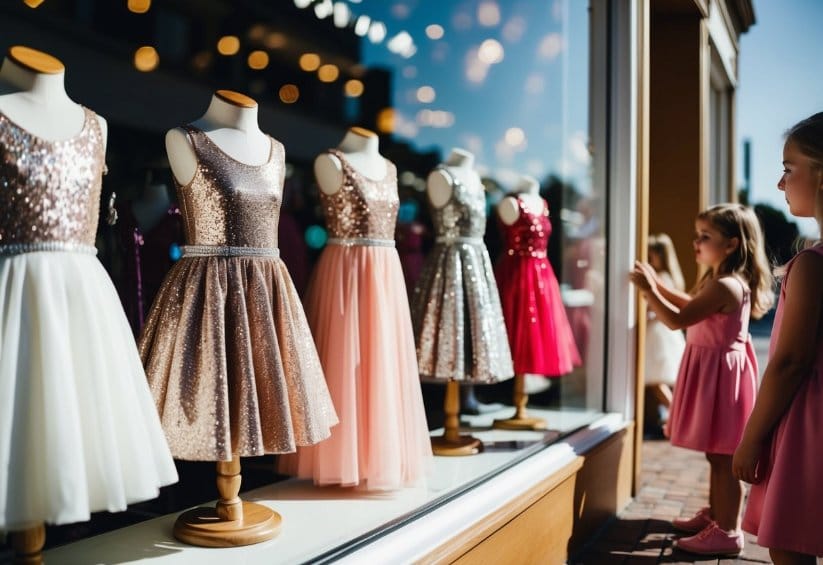
Sparkly clothing plays a significant role in social dynamics. It influences how people perceive themselves and others in social settings. The choice to wear glittery garments can impact one’s sense of belonging and self-expression.
Peer Group Influence and Belonging
Wearing sparkly clothing often reflects peer group trends. Young people may feel pressure to don glittery outfits to fit in with their social circle. This can create a sense of unity and shared identity among friends.
Sparkly attire can also serve as a conversation starter. It draws attention and may help shy individuals connect with others more easily. In some peer groups, the level of glitter one wears might even indicate social status.
However, excessive focus on sparkly clothing can lead to conformity issues. Some may feel left out if they cannot afford or do not wish to wear such eye-catching garments.
Clothing as a Statement of Empowerment
Sparkly clothing can be a powerful tool for self-expression and empowerment. Many people use glittery outfits to boost their confidence and stand out in a crowd. This bold fashion choice often symbolises defiance against societal norms.
For some, wearing sparkles is a way to celebrate their identity. It can be particularly meaningful for members of the LGBTQ+ community as a form of visibility and pride.
Glittery clothing can also challenge gender stereotypes. Men wearing sparkly attire may be seen as breaking traditional masculine fashion norms. This can contribute to broader conversations about gender expression and equality.
Material and Design Aspects
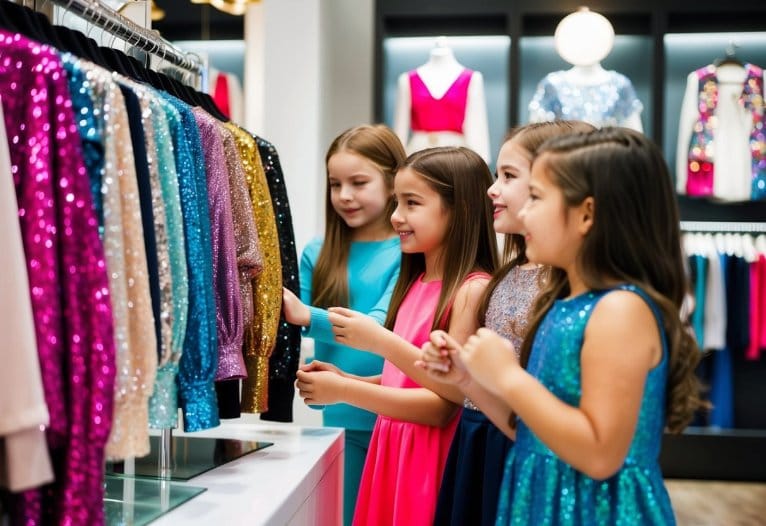
Sparkly clothing captivates girls through clever use of shimmering materials and innovative design techniques. The interplay of light and texture creates eye-catching effects that appeal to many.
Different Types of Sparkly Materials
Glitter and sequins are two popular choices for adding sparkle to clothing. Glitter consists of tiny reflective particles, often made from plastic or metal. Sequins are small, flat discs sewn onto fabric.
Metallic threads woven into fabric create a subtle shimmer. Designers also use rhinestones, crystals, and beads to add sparkle and texture.
Holographic fabrics change colour as they move, creating a mesmerising effect. Iridescent materials reflect different colours depending on the angle of light.
Innovation in Clothing Embellishment
Designers constantly develop new ways to incorporate sparkle into dress designs. Heat transfer techniques allow for intricate glittery patterns on fabric.
3D printing technology creates unique textured embellishments. Some designers experiment with light-up elements, embedding tiny LEDs into clothing for a twinkling effect.
Eco-friendly options are emerging, such as biodegradable glitter made from plant cellulose. This addresses environmental concerns while maintaining the desired sparkly look.
Fashion Statements and Self-Expression
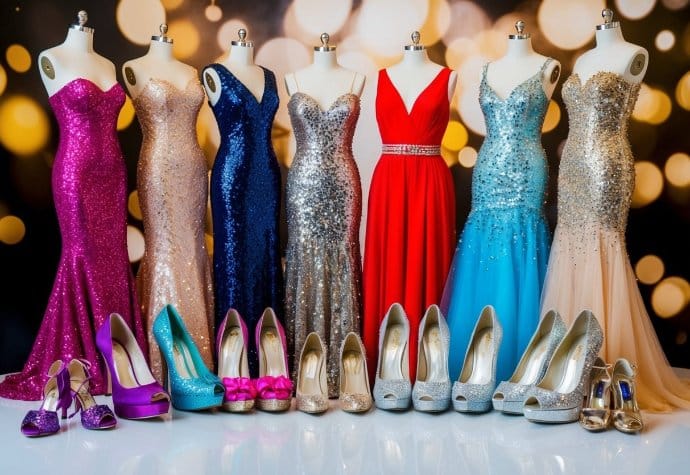
Girls often use sparkly clothing to show their personality and style. Shiny outfits can make bold statements and express creativity.
Sparkly Attire as a Form of Individuality
Glittery clothing helps girls stand out from the crowd. Many use sequins and rhinestones to reflect their inner selves. Sparkly tops or dresses catch the eye at parties or events.
Some girls prefer subtle shimmer, while others go all-out with head-to-toe glitter. This range shows how sparkles allow for personal expression. A girl might wear a sparkly hairband one day and glittery trainers the next.
Shiny clothes can boost confidence too. Putting on a sparkly outfit often makes girls feel special and unique. It’s a way to celebrate their individuality through fashion.
Recommended products
Baby girl sequin dress – Gold
Price range: 22,00 € through 27,00 €Flower girl sequin tulle dress – Grey
22,00 €Half sleeve sequin flower girl dress – Champagne
96,00 €Girls sequin party dress
10,00 €Girl rainbow sequin dress – Purple
25,00 €
The Role of Shiny Clothing in Camp Style
Camp fashion embraces over-the-top, playful looks. Sparkly clothes fit right in with this bold style. Think of pop stars in glittery costumes or drag queens in sequin gowns.
Camp uses irony and exaggeration. Super shiny outfits can achieve this effect. A girl might wear a sparkly tracksuit to poke fun at sporty styles. Or she could don a glittery formal dress for a casual outing.
This style lets girls play with gender norms too. They might mix masculine items with sparkly, feminine pieces. It’s all about challenging fashion expectations and having fun with clothes.
Comfort vs Style in Fashion Choices
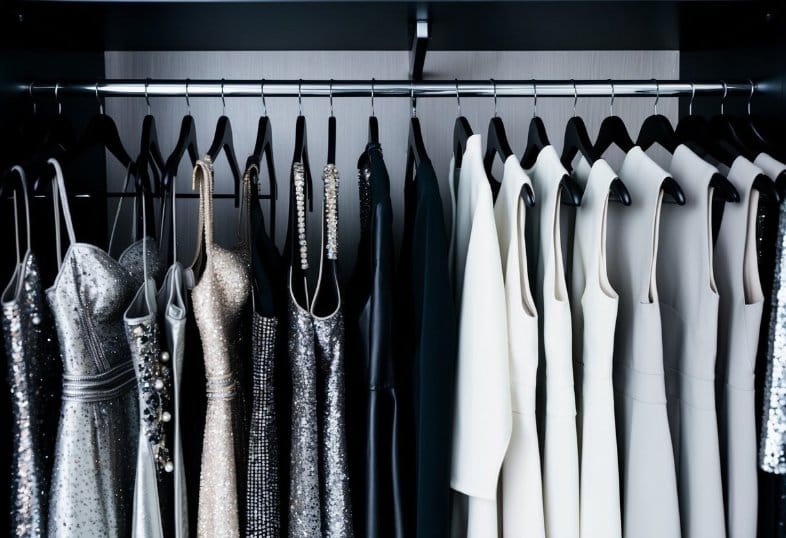
Fashion choices often involve balancing comfort and style. Personal preferences and body image play key roles in deciding which to prioritise.
Prioritising Comfort in Clothing Selection
Many girls opt for comfort in their daily attire. Soft fabrics and loose fits allow for easy movement and relaxation. Casual clothing often boosts mental well-being, making it ideal for lounging or quiet activities.
Comfortable shoes like trainers or flats are popular choices. They reduce foot pain and fatigue during long days. Stretchy materials like leggings or jersey dresses provide flexibility and ease.
Body image concerns may lead some to choose looser, more forgiving styles. These can help boost confidence by concealing perceived flaws. Comfort-focused fashion doesn’t mean sacrificing style, though. Many brands now offer trendy yet cosy options.
When Style Takes Precedence
Some occasions call for putting style first. Special events or professional settings often require more formal, structured clothing. High heels, fitted dresses, and tailored suits may be less comfortable but create a polished look.
Dressing for confidence can mean choosing eye-catching pieces over comfort. Bold colours, unique designs, or luxurious fabrics can help girls stand out and feel powerful.
Personal style expression sometimes trumps comfort. Fashion-forward girls might endure less comfy clothes to showcase their creativity. Tight jeans, corsets, or avant-garde designs prioritise aesthetics over ease.
Body image can also drive style-first choices. Girls may opt for shapewear or form-fitting clothes to highlight their figure, even if less comfortable.
Societal Perception of Revealing and Sparkly Attire
Revealing and sparkly clothing often sparks debate about appropriateness and intentions. These styles can affect how people are perceived in different social settings.
Revealing Clothes in Social Settings
Revealing clothing can elicit mixed reactions depending on the context. In casual settings like beaches or nightclubs, it may be more accepted. However, in formal or professional environments, it might be seen as inappropriate.
Some view revealing attire as a form of self-expression and confidence. Others may perceive it as attention-seeking or unprofessional. Cultural norms and personal values play a big role in these judgements.
The media’s portrayal of revealing clothes can shape public opinion. It often associates such attire with youth, beauty, and sexuality. This can influence how people view those who wear revealing outfits in everyday life.
Attitudes Towards Attention-Seeking Behaviour
Sparkly and revealing clothes often draw attention. Some see this as a positive way to express oneself. Others may view it as an attempt to gain unnecessary focus.
Society’s perception of attention-seeking through clothing varies. It can be seen as:
- Confident and bold
- Insecure or needy
- A form of personal branding
- Disruptive or inappropriate
These views can affect how people treat those wearing eye-catching outfits. It may lead to positive attention, but also unwanted comments or judgements.
The intent behind wearing such clothes is often misunderstood. What one person sees as fun fashion, another might view as a cry for attention. This gap in perception can lead to social conflicts or misunderstandings.
Influence of Media and Celebrities
Media and celebrities play a big role in shaping fashion trends, especially when it comes to sparkly clothing. They often set the tone for what’s popular and desirable in social settings.
Celebrity Fashion as a Trendsetter
Celebrities have a huge impact on fashion. When famous people wear sparkly outfits, fans often want to copy the look. This can lead to a surge in demand for shiny clothes.
Social media makes it easy for stars to show off their glittery styles. A single post can reach millions of followers in minutes. This quick spread of fashion ideas helps sparkly trends catch on fast.
Award shows and red carpet events are prime spots for celebs to showcase dazzling outfits. These glamorous looks often inspire everyday fashion choices.
Media’s Role in Promoting Shiny Fashion
TV shows, magazines, and films all help push sparkly fashion trends. They often feature eye-catching, glittery outfits that grab attention.
Fashion magazines regularly highlight sparkly clothes. This exposure makes shiny styles seem more desirable and fashionable.
Online media also plays a part. Blogs and fashion websites often showcase sparkly items, making them seem like must-have pieces.
Adverts for clothing brands frequently use sparkle to draw the eye. This tactic helps make shiny fashion feel exciting and worth buying.
Frequently Asked Questions
Sparkly clothing holds a special allure for many women. The attraction stems from psychological, cultural, and aesthetic factors that influence fashion choices and perceptions of femininity.
What psychological aspects lead to the preference for glitter in women’s attire?
Glittery clothing often appeals to our innate attraction to shiny objects. This preference may be rooted in evolutionary psychology, where glossy surfaces were associated with water and valuable resources.
The sparkle can also evoke feelings of joy and excitement, triggering positive emotions when worn or seen.
What is the cultural significance of sequined dresses in women’s fashion?
Sequined dresses are often linked to glamour, luxury, and special occasions. They symbolise celebration and stand out in social settings.
In many cultures, these dresses are worn to formal events, parties, and performances, signifying a festive or important atmosphere.
Why is shiny attire often associated with femininity?
Historically, fashion trends have connected shiny fabrics and embellishments with women’s clothing. This association has been reinforced through media, advertising, and cultural norms.
The softness and light-reflecting properties of sparkly materials may also align with traditional notions of feminine aesthetics.
What attracts women to clothes with sparkly embellishments?
Sparkly clothes can boost confidence and self-expression. They allow wearers to stand out and make a statement.
Many women enjoy the transformative effect of glittery garments, which can add a touch of glamour to everyday outfits.
How do sparkling elements in clothing influence perception and attractiveness?
Sparkly clothing tends to draw attention, making the wearer more noticeable in social situations. This can enhance perceived attractiveness and charisma.
The reflective quality of sequins and glitter can also create a flattering effect, softening features and adding a radiant glow to the skin.
What terminology is used to describe sparkly features on garments?
Common terms include sequins, glitter, rhinestones, and metallic threads. These describe different types of shiny embellishments used in clothing.
Other descriptors like ‘iridescent’, ‘shimmery’, and ‘holographic’ are often used to characterise the light-reflecting properties of sparkly fabrics.
Related Post: What You Need to Know About Sequins

